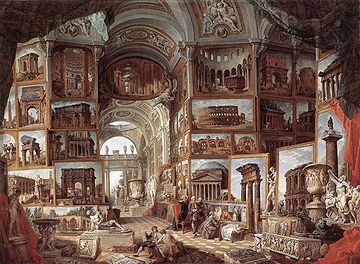
Capriccio (painting)
Encyclopedia

Staffage
In painting, staffage, pronounced "staffarge" as in French, are the human and animal figures depicted in a scene, especially a landscape, that are not the primary subject matter of the work. Before the adoption of the word into the visual arts in the late eighteenth and early nineteenth centuries,...
of figures. It fits under the more general term of landscape painting. It may also be used of other types of work with an element of fantasy.
This genre was perfected by Marco Ricci
Marco Ricci
Marco Ricci was an Italian painter of the Baroque period. He was the nephew of Sebastiano Ricci. After receiving his first instruction in art from his uncle, he visited Rome, where he was for some years occupied in drawing vedute....
but its best-known proponent was the artist Giovanni Paolo Pannini
Giovanni Paolo Pannini
Giovanni Paolo Panini or Pannini was a painter and architect, who worked in Rome and is mainly known as one of the vedutisti ....
. This style was extended in the 1740s by Canaletto
Canaletto
Giovanni Antonio Canal better known as Canaletto , was a Venetian painter famous for his landscapes, or vedute, of Venice. He was also an important printmaker in etching.- Early career :...
in his etched vedute ideale, and works by Piranesi and his imitators.
Later examples include Charles Robert Cockerell
Charles Robert Cockerell
Charles Robert Cockerell was an English architect, archaeologist, and writer.-Life:Charles Robert Cockerell was educated at Westminster School from 1802. From the age of sixteen, he trained in the architectural practice of his father, Samuel Pepys Cockerell...
's A Tribute to Sir Christopher Wren and A Professor's Dream, and Joseph Gandy's 1818 Public and Private Buildings Executed by Sir John Soane. The artist Carl Laubin has painted a number of modern capriccios in homage to these works.
The term can be used more broadly for other works with a strong element of fantasy. The Capricci, an influential series of etching
Etching
Etching is the process of using strong acid or mordant to cut into the unprotected parts of a metal surface to create a design in intaglio in the metal...
s by Gianbattista Tiepolo (1730s?, published in 1743), reduced the architectural elements to chunks of classical statuary and ruins, among which small groups made up of a cast of exotic and elegant figures of soldiers, philosophers and beautiful young people go about their enigmatic business. No individual titles help to explain these works; mood and style are everything. A later series was called Scherzi di fantasia - "Fantastic Sketches". His son Domenico Tiepolo was among those who imitated these prints, often using the term in titles.
Goya's series of 80 prints
Old master print
An old master print is a work of art produced by a printing process within the Western tradition . A date of about 1830 is usually taken as marking the end of the period whose prints are covered by this term. The main techniques concerned are woodcut, engraving and etching, although there are...
Los Caprichos
Los Caprichos
Los Caprichos are a set of 80 aquatint prints created by the Spanish artist Francisco Jose de Goya in 1797 and 1798, and published as an album in 1799. The prints were an artistic experiment: a medium for Goya's condemnation of the universal follies and foolishness in the Spanish society in which...
, and the last group of prints in his series The Disasters of War
The Disasters of War
The Disasters of War are a series of 8280 prints in the first published edition , for which the last two plates were not available. See "Execution". prints created between 1810 and 1820 by the Spanish painter and printmaker Francisco Goya...
, which he called "caprichos enfáticos" ("emphatic caprices") are far from the spirit of light-hearted fantasy the term usually suggests. They take Tiepolo's format of a group of figures, now drawn from contemporary Spanish life, and are a series of savage satires and comments on its absurdity, only partly explicated by short titles.

